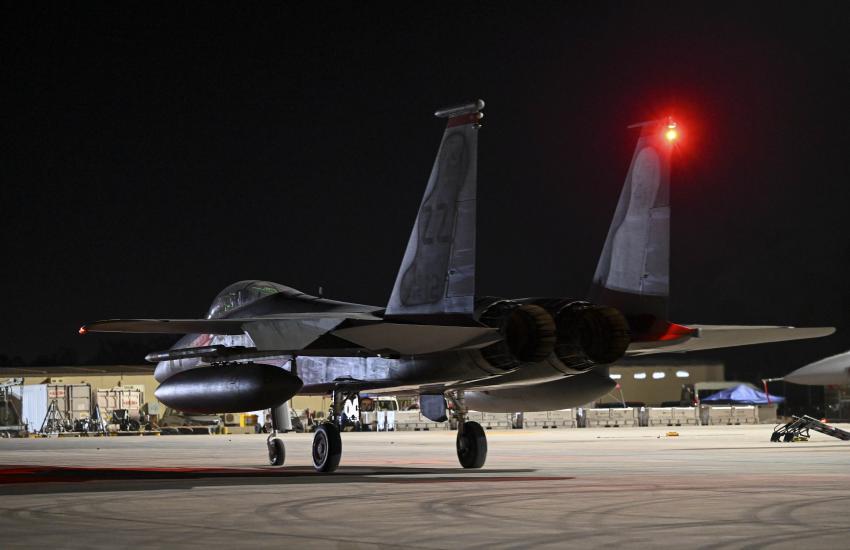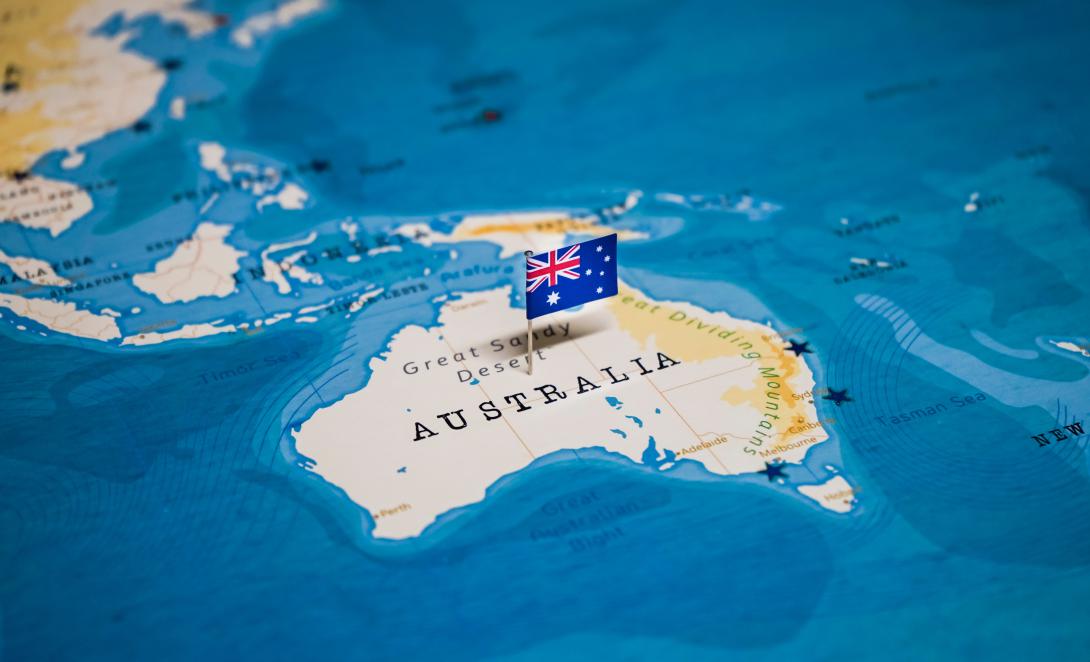Air Components Strengthen Ties With Australia
Driven by shifting geopolitics in the Indo-Pacific region and the world, the Commonwealth of Australia and the United States are strengthening their military interoperability. The two nations are building on their strong and historic ties, with the U.S. Air Force and the Royal Australian Air Force in particular, working to become more integrated across ground support and air capabilities.
“The alliance and relationship we have with the United States, it underpins the way that we engage with our neighbors in the South Pacific to ensure that we can play our part as a nation and with our partners in the region to keep that part of the world free and open,” stated Air Commodore John Haly, Royal Australian Air Force (RAAF), and the air and space attaché in Washington, D.C., speaking with SIGNAL and other reporters on a media call from Alaska during U.S. Exercise Red Flag. “Fundamentally, what we are seeking to do is to create an environment together, with a partnership of nations, where each nation, no matter what the size, is able to [grow and prosper] in a way that is fair and reasonable and [with] international law.”
“We’ve gotten to see each other all over the world in the last year,” said Commander of the U.S. Pacific Air Forces (PACAF) Gen. Kenneth Wilsbach, USAF, speaking about Air Commodore Haly on the call. Gen. Wilsbach also is the air component commander for the U.S. Indo-Pacific Command and the executive director, Pacific Air Combat Operations Staff, Joint Base Pearl Harbor-Hickam, Hawaii. “It really speaks to the close relationship we have with Australia.”
The sixth largest country in the world, Australia has been bolstering its military and technological capabilities—in the last year especially—to be a stabilizing force in the Indo-Pacific, maintaining the global order set by allies and partners that has underpinned peace and prosperity for decades in the region. The Australian Defence Force is now hosting U.S airmen and Marines regularly, integrating at levels not seen before with more warfighters. In addition, the two nations are growing their operational experience with many other countries to form a united front in the region.
The recent growth between the United States and Australia stems from the 31st Australia-United States Ministerial Consultations, known as AUSMIN 2021, an annual meeting that helps the nations set their mutual military and foreign relations priorities. During the meetings last year, the two countries agreed to strengthen their existing 2014 Force Posture Agreement by increasing land, maritime and air cooperation in Australia—with expanded air cooperation set under the Enhanced Air Cooperation (EAC) piece of the Force Posture Agreement.
The two nations also sought to create a combined logistics, sustainment and maintenance enterprise in Australia to support advanced warfighting and partner military operations in the region. In addition, they agreed to “conducting more complex and more integrated exercises and greater combined engagement with allies and partners” in the region.
The countries increased their Marine Rotational Force program as well, with the Australian Army and the RAAF hosting U.S. Marines in country. That program reached an initial milestone of 2,500 Marines in 2019 before COVID-19 and is now “a highly capable force that provides significant opportunities to enhance interoperability” with the Australian military.
“Expanded cooperation between Australia and the U.S. through two Force Posture Initiatives–the Marine Rotational Force-Darwin and the EAC–has been instrumental in enhancing the capabilities and interoperability of both nations through joint exercises and activities,” an Australian defense spokesperson told SIGNAL. “The EAC aims to deepen advanced air-to-air integration between the RAAF and the United States Air Force to enable us to operate together seamlessly. It has been successfully operating since 2017 as one of the United States Force Posture Initiatives. EAC strengthens our ability to work together and provide opportunities to extend our combined technical skills and logistics training. The EAC also provides opportunities to enhance Australian and U.S. engagement with regional partner air forces through involvement in exercises and training activities, promoting security cooperation.”
In fiscal year 2022 alone, the EAC saw U.S. F-22 Raptor aircraft to RAAF Base Tindal in the Northwest Territory, near the town of Katherine; B-1 Lancers and F-15C Eagles to RAAF Base Darwin, on the coast of the Northwest Territory; and B-2 Spirit Stealth Bombers to RAAF Base Amberley, southwest of Brisbane in Queensland. The U.S. airmen and the various assets participated in many exercises in Australia in 2022, including: Pitch Black, Diamond Storm; Koolendong; and Arnhem Thunder.
“These versatile platforms visiting Australian bases and utilizing Australian infrastructure and support services is a testament to how well the Australian and U.S. militaries assimilate,” the Australian defense spokesperson said.
When pressed, PACAF would not disclose more details about the U.S. airmen located in Australia, given security concerns. The command did emphasize that one of the goals of the United States being in that country is to prepare a robust international force against near-peer competition.
“Although we cannot speak to exact force numbers or locations, PACAF seeks varied opportunities for integrating with the RAAF to safeguard our shared regional security interests,” a PACAF spokesperson explained. “During Pitch Black 22, 17 nations operated from RAAF Darwin and RAAF Tindal to build multilateral defense capabilities in northern Australia. U.S. Air Force F-22 Raptors from Joint Base Pearl Harbor-Hickam, Hawaii, also recently trained with RAAF forces at Tindal. Additionally, Gen. Wilsbach recently conducted a trilateral flight with RAAF Air Marshal Rob Chipman and German Air Force Air Chief Lt. Gen. Ingo Gerhartz, to demonstrate friendship and cooperation over Australia’s Northern Territory.”
The increased cooperation continues with plans for next year. “Over the course of 2022-23, the United States and Australia will be involved in various joint and single-service exercises and activities, the largest of which is the upcoming biannual Exercise Talisman Sabre 2023,” stated the Australian defense spokesperson. “2023 will mark the tenth iteration of the exercise. Exercise Talisman Sabre is the largest bilateral combined training activity between the Australian Defence Force and the U.S. military.”
For the U.S. Air Force, and PACAF specifically, the assimilation efforts are about fine-tuning how U.S. warfighters operate in Australia and the region.
“PACAF and the RAAF enhance interoperability through bilateral and multilateral exercises and operations, such as Red Flag-Alaska and Pitch Black,” the representative from PACAF said. “Although our forces are highly interoperable, we look for opportunities to refine TTPs [tactics, techniques and procedures], simulate increasingly challenging real-life scenarios and demonstrate our resilience to Indo-Pacific nations.”

The increased alliance also is helping the United States with its fielding process for the E-7 Wedgetail, a highly advanced airspace battle management capability. Australia has brought it over to several recent events, integrating it with U.S. aircraft and allowing officials to view the aircraft.
“I’ve been on record wanting the E-7 as soon as possible for the U.S. Air Force,” Gen. Wilsbach noted. “The Royal Australian Air Force was the first country to employ that aircraft, and it is a fantastic aircraft. I’ve had a chance to fly on it and fly with it, and it is an incredible advancement of capabilities.”
Australia, which has a decade of experience with its E-7A Wedgetail Boeing 737-700 IGW aircraft, holds a fleet of six E-7As operated by its No. 2 Squadron located at RAAF Base Williamtown, near Newcastle, according to the RAAF.
“With its ability to command and control large areas of airspace, the Wedgetail’s ability to coordinate a joint air, sea and land battle in real time significantly increases the effectiveness of the Australian Defence Force,” the Australian service stated. “The E-7A Wedgetail is a force multiplier with its long-range surveillance and communications capabilities. During a standard mission, the E-7A Wedgetail can cover more than 4 million square kilometers, an area the size of Western Australia or the Northern Territory.”
In August, Australia brought over several Wedgetails to Alaska for Red Flag. The exercise combined U.S. fifth-generation aircraft, including F-22s and F-35s, at the Joint Pacific Air Readiness Complex, which holds almost 100 aircraft.
“Australia is always happy to participate in exercises with the United States, like Red Flag Alaska,” Commodore Haly noted. “Same time last year, [we did] great work, and the year between these two activities, we saw how much our forces have grown apart and together in order to rejoin and conduct this activity. The role that this plays in continuing improvements in interoperability and integration is very crucial to the Australian Defence Force. And it is not just in the overall obvious flying elements but also with our intelligence, our planners, our administration, human resources and logistics. When you think of Red Flag, you think of aircraft, and that is certainly true, but there are elements of cyber, space and also special operations, Army infantry or flying operations. There are certainly airlift and medevac. There is a lot happening that may not be obvious.”
In September, about 110 U.S. airmen from PACAF participated in Exercise Pitch Black 2022 in Australia, working on “tactical execution of large force employment offensive counter air and counter land operations in a multinational coalition environment,” according to a report from PACAF, written by Staff Sgt. Savannah Waters. The two countries worked on enhancing interoperability with forces from Canada, France, Germany, India, Indonesia, Japan, Malaysia, Netherlands, New Zealand, Philippines, Republic of Korea, Singapore, Thailand, United Arab Emirates and the United Kingdom. The militaries, outfitted with about 100 aircraft, flew air operations in northern Australia out of RAAF Darwin and RAAF Tindal.
“The global rules-based order is under pressure now in a significant way as we’ve perhaps seen since the end of the second world war, and in this moment to have a sense of shared mission and to be projecting forward with a sense of team is really important, said Australia’s second-in-charge, Deputy Prime Minister Richard Marles, speaking with reporters at the Australian Embassy in Washington, D.C., last summer during the Albanese government’s first trip to the United States. “That is part of what we’ve been seeking to express with the U.S. government. And we’ve really felt that reciprocated…. And is a real sense of shared mission between Australia and the United States.”





Comments